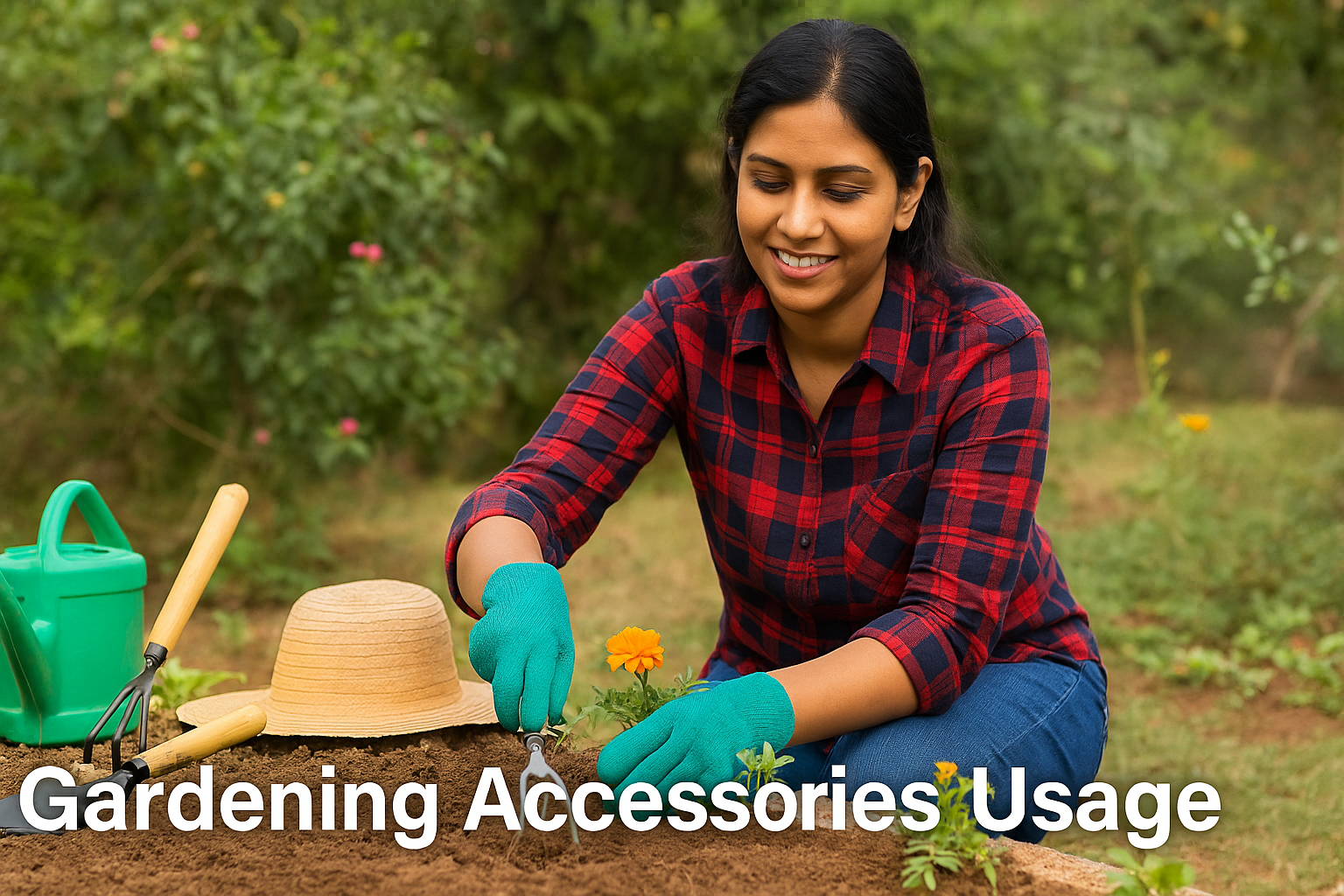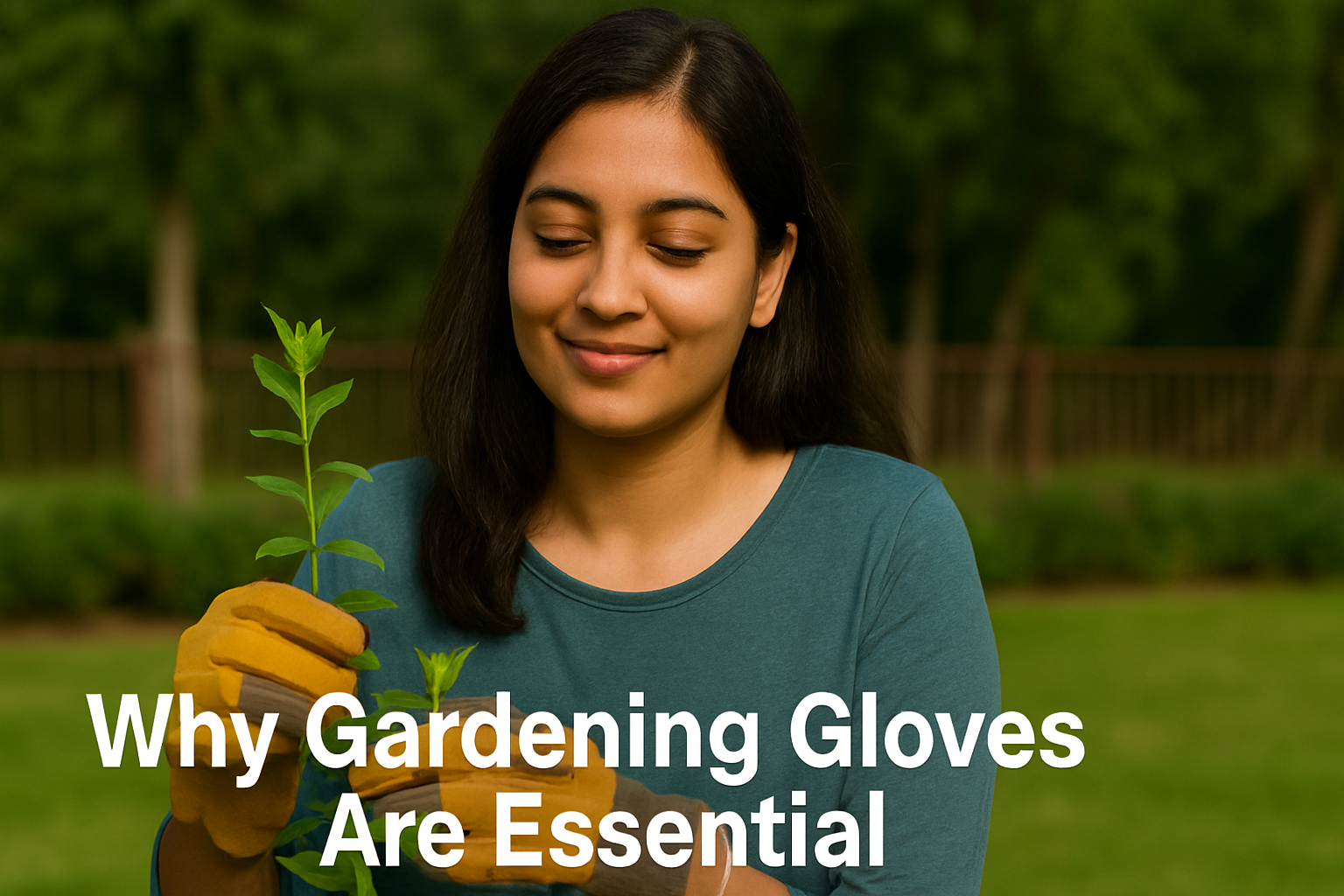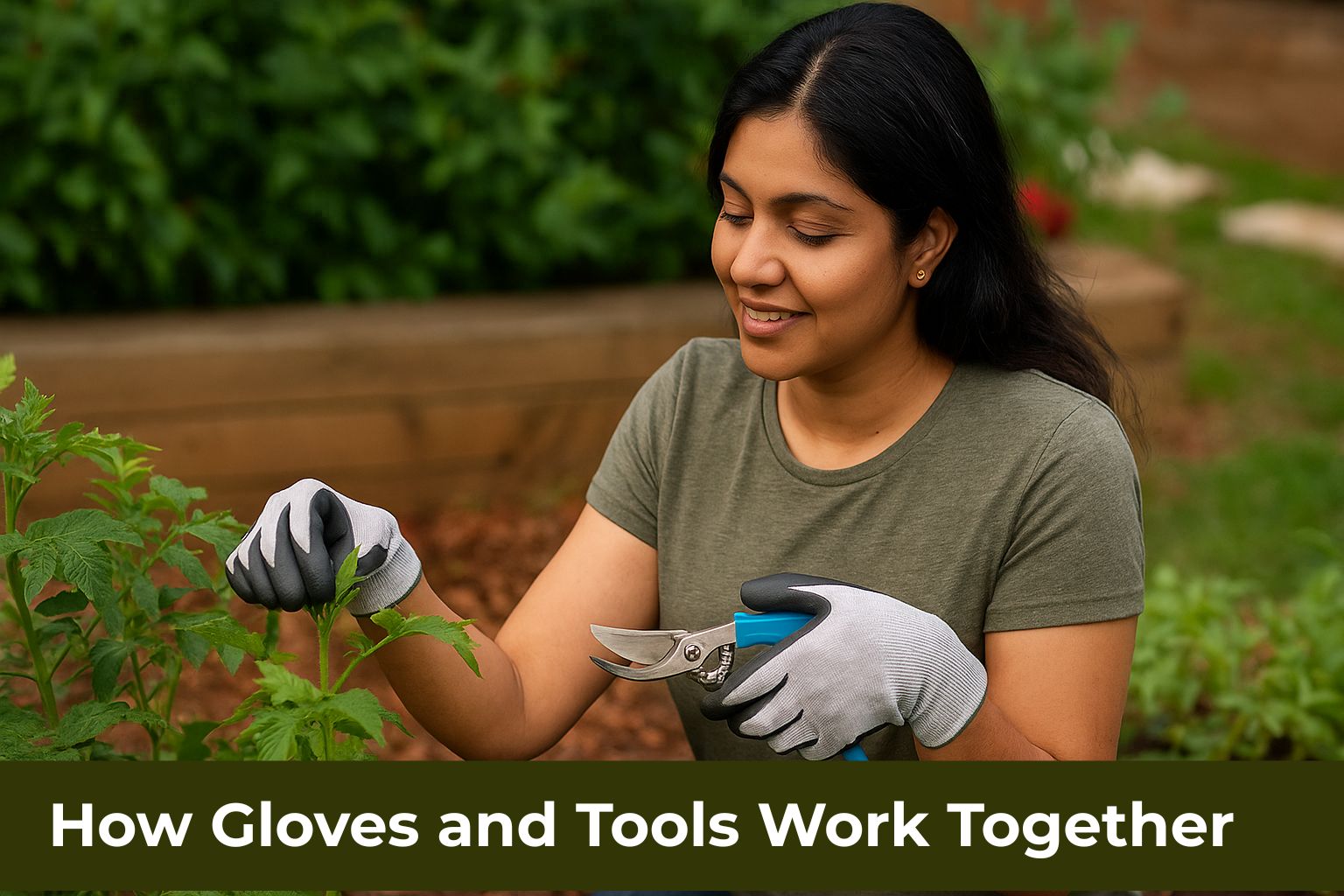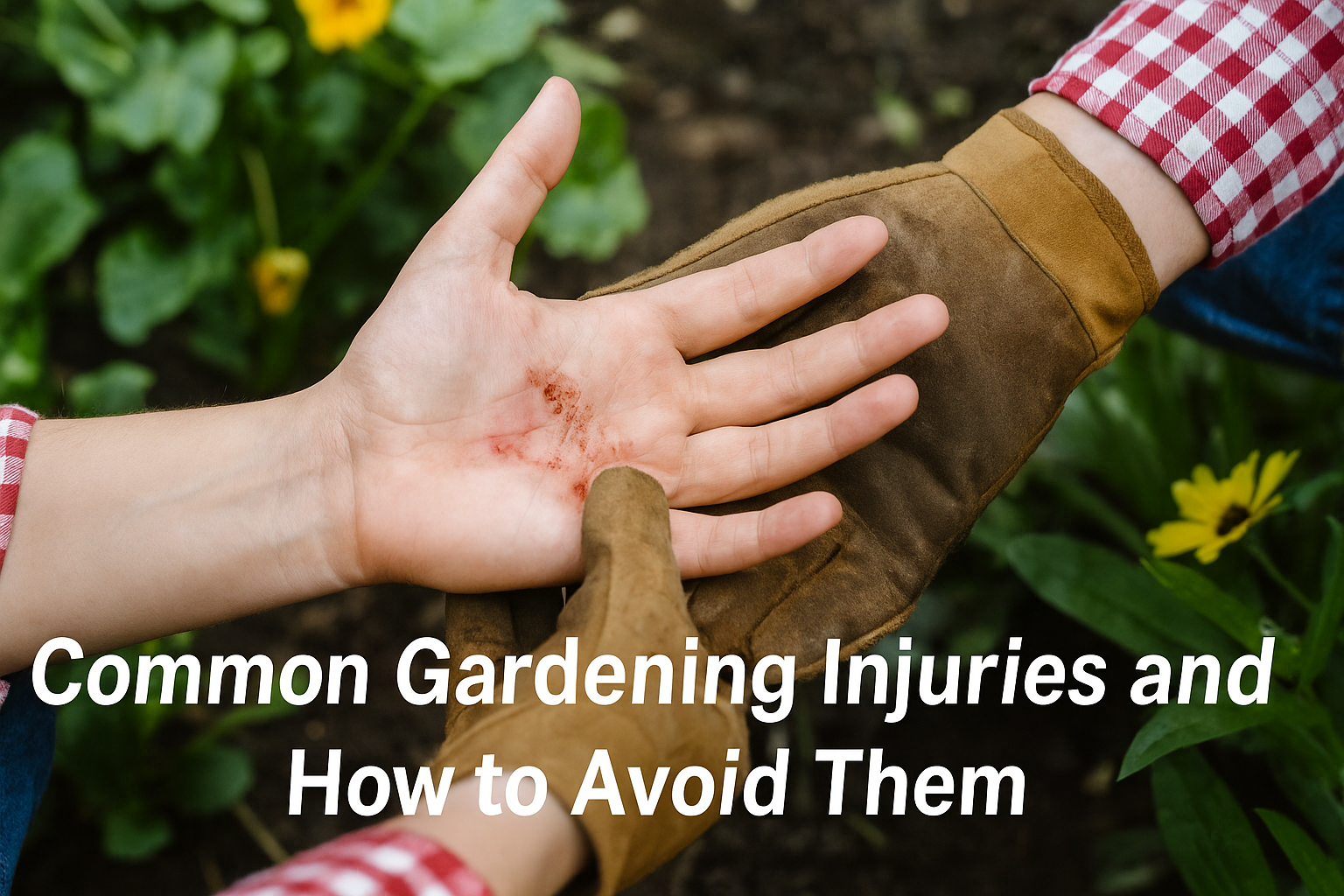.jpg)
Gardening is a gratifying hobby, but it comes with physical demands.
From thorny bushes to heavy tools, the garden can pose risks if you’re not prepared.
For beginner and urban gardeners, understanding gardening gloves and safety is key to nurturing plants while protecting yourself.
This article covers safety practices in gardening, emphasizing why the best gardening gloves and proper gear matter for injury prevention.
We’ll also explore garden protection tips, safe tool usage, and how urban gardeners can adapt safety measures for compact spaces.
Even seemingly simple tasks can lead to common injuries like cuts, blisters, and strains. Each year, over 400,000 gardening injuries result in emergency room visits. These include:
- Cuts and scrapes: Often from thorny plants or sharp tools. Wear gloves and long sleeves to shield your skin. Heavy gloves and appropriate attire help avoid scratches and punctures.
- Blisters: Friction from using tools can cause painful blisters, especially on hands and feet. This is why gloves and proper grip techniques are vital. We’ll detail how to avoid blisters in gardening later.
- Strains and sprains: Bending awkwardly or lifting heavy pots can strain muscles. Use your legs to lift, keep tools within easy reach, and take breaks to prevent overexertion.
- Falls and trips: Garden clutter like hoses or uneven ground can cause falls. Keep pathways clear and be mindful of where you step, especially when using ladders or stools.
How to avoid these injuries
- Proper attire: Wear long pants, closed-toe shoes, and a hat. Gloves are non-negotiable, protecting hands from cuts, thorns, and even sun exposure.
- Tool awareness: Always place tools like rakes and shovels tines-down when not in use to avoid stepping on sharp ends. Keep blades covered or locked when carrying them.
- Good form: Bend at the knees, not the waist, when lifting heavy pots. Vary your tasks to avoid repetitive strain – e.g., alternate between digging and pruning.
- First aid ready: Keep a basic first aid kit nearby for minor cuts or bug bites. Clean any wound thoroughly to prevent infections (soil harbors bacteria). And remember your tetanus shot – a third of tetanus cases come from gardening injuries.
Also Read These Gardening Aticles
How to Grow Chrysanthemum (Guldaudi) Seeds at Home | Step-by-Step Care Guide
Top 13 Eco-Friendly Planters For A Sustainable Home Gardening
Gardening Accessories Usage and Their Role in Safety

Beyond gloves, gardening accessories play a huge role in keeping you safe and comfortable:
- Kneepads and cushions: Save your knees when planting or weeding. They reduce pressure and prevent long-term aches.
- Sun protection: A wide-brimmed hat and sunscreen (SPF 30+) guard against sunburn during long gardening sessions. Hydrate often to avoid heat exhaustion.
- Protective eyewear: If you’re pruning or mowing, wear safety glasses. Debris can fly unexpectedly, and eye protection is essential.
- Proper footwear: Sturdy, closed-toe shoes or boots prevent injuries from dropped tools or stepping on sharp objects. Never garden in sandals – even in urban balconies, heavy pots or tools can hurt your toes.
Gardening accessories usage tips
- Always inspect your tools and gear before use. A rusty trowel or cracked handle can break and cause injury. Clean and sharpen tools regularly for safer handling.
- Organize your workspace. Use tool racks or buckets to keep everything in place. Fewer hazards on the ground means fewer accidents.
- Gloves as part of PPE: Think of gloves as part of your gardening “armor” alongside eyewear and boots. Together, these safety accessories greatly minimize risk. High-quality gardening gloves (and safety) gear can truly make gardening safer and more enjoyable.
Why Gardening Gloves Are Essential

Gardening gloves are a gardener’s best friend. They’re not just about comfort – they’re about safety and health:
- Prevent cuts and infections: Soil carries bacteria and fungi. Even a tiny cut can lead to infection if unprotected. Gloves create a barrier against these microbes, as well as against fertilizers and pesticides that could irritate your skin.
- Avoid thorn and bite injuries: If you’ve ever pruned a rose or reached into dense shrubs, you know how vicious thorns can be. Quality gloves (especially leather ones) shield you from thorny scratches and even insect or spider bites lurking under leaves.
- Reduce blisters: Blisters are common when raking or digging for long periods. A good pair of gloves minimizes friction and protects vulnerable pressure points on your hands.
- Improve grip and control: Many best gardening gloves have textured palms (like nitrile or latex coatings) that give you a better grip on tools. This means less chance of tools slipping and causing accidents.
- Keep hands clean and sun-safe: Aside from dirt, gloves prevent sun damage to your hands and keep your fingernails cleaner. No more stubborn dirt under nails after a satisfying day of planting!
Remember, even simple chores like handling compost can pose risks. The Royal Horticultural Society advises wearing gloves whenever handling soil, compost, or potentially harmful plants. In short, gloves = safety in the garden.
How to Choose Gardening Gloves: Important Features to Consider
.png)
Not all gloves are created equal. To fully enjoy safe gardening practices, choose gloves that fit the task and your hands. Here’s what to look for:
- Material matters: Select gloves based on the work you’ll do. Leather gloves are tough and great for heavy-duty tasks (like pruning roses or handling stones). Cotton gloves are lightweight and breathable for light tasks, while rubber or nitrile-coated gloves are water-resistant and good for wet conditions. We’ll cover the best material gloves for gardening in detail next.
- Proper fit: A glove that’s too loose can slip off, and one that’s too tight might tear or restrict movement. Try them on if possible. You want a snug fit without sacrificing flexibility. Look for gloves with adjustable wrist straps to keep dirt out and fit secure.
- Thickness vs. dexterity: Thicker gloves (like heavy leather) protect more but can reduce your finger dexterity. For tasks like seeding or transplanting delicate seedlings, you might prefer thinner gloves or those with fingertips that allow more sensitivity. Some gloves even have touchscreen-compatible fingertips for those who use their phone in the garden!
- Grip and texture: Many of the best gardening gloves feature textured palms or silicone dots for better grip. This is especially helpful when using hand tools or carrying pots to avoid slips.
- Length and coverage: Standard gloves cover your hands and wrists, but for thorny or poisonous plants (like ivy), consider gauntlet-style gloves that extend up your forearm for extra protection.
- Breathability: Sweaty hands can be uncomfortable. Gloves with breathable backs (mesh or fabric) help keep hands cooler on hot days. If you garden in very warm climates, this feature is crucial.
- Easy to clean: Gloves will get dirty. Ideally, choose gloves that are machine-washable or easy to rinse off, so you can keep them clean and prolong their life.
Choose premium gardening gloves with super quality form Urban Plant
Pro Tip: Always have more than one pair of gloves. Use heavy-duty gloves for tough jobs and lighter gloves for precision tasks. This way, you’ll extend the life of each pair and always have dry gloves on hand if one pair gets wet or muddy.
Best Material Gloves for Gardening: A Complete Guide
What are the best material gloves for gardening? It depends on what you’re doing. Here’s a rundown of common glove materials and their pros and cons:
- Leather Gloves: Often made from cowhide, goatskin, or deerskin. Pros: Extremely durable and great for heavy-duty work – think handling thorny branches or shoveling gravel. Good resistance to thorns and even snake bites. Cons: Can be less flexible until broken in, and not waterproof. They might get stiff after drying if they become soaked, though goatskin is more supple even after wetting. Perfect as gloves for heavy-duty gardening tasks.
- Cotton Gloves: Light, breathable, and inexpensive. Pros: Comfortable for light tasks like potting or sowing seeds. They keep hands clean and cool. Cons: Offer minimal protection against thorns or wetness. They can get soggy and dirty quickly.
- Rubber or Latex-Coated Gloves: These have a fabric (often polyester) base with a palm coating of rubber, latex, or nitrile. Pros: Excellent for grip and avoid blisters in gardening because they reduce friction. They’re also water-resistant – great for working with moist soil or during watering. Cons: The coating can make them less breathable (sweaty hands).
- Nitrile Gloves (Disposable): For handling chemicals like pesticides or fertilizers, or very dirty jobs (like mixing compost), thin nitrile disposable gloves can be worn alone or under your regular gloves. Pros: They’re waterproof and tight-fitting, providing a second skin. Cons: Not durable for tough tasks and create waste (though you can find thicker reusable nitrile gloves).
- Synthetic Leather and Specialty Fabrics: Many modern best gardening gloves use synthetic leather (often paired with spandex or mesh) to combine toughness with flexibility. Pros: Often as protective as leather but more lightweight and sometimes machine washable. Cons: Quality varies, so look for reputable brands. Great for gloves for heavy-duty gardening if you prefer vegan options or something that dries faster than real leather.
- Bamboo or Hemp Gloves: Eco-friendly gloves made from sustainable fibers like bamboo offer good breathability and natural antibacterial properties. Pros: Gentle on skin, breathable, and sustainable. Cons: Not as rugged as leather, but good for general use and aligning with gardening accessories usage if you prefer green materials.
When choosing, think about your typical gardening day. Are you pruning thorny roses, digging trenches, or just deadheading flowers? Match the glove material to your needs.
How to Avoid Blisters in Gardening: Practical Tips
Blisters can turn a pleasant afternoon of gardening into a painful ordeal.
They’re caused by friction – repeated rubbing of your skin against a tool or even inside a glove. Here’s how to nip blisters in the bud:
- Wear Gloves with Padding: Some gloves have extra padding on the palms and fingers. These cushion your hands while raking or digging, reducing friction points. If blisters are a big issue for you, look for gloves labeled “blister resistant” or use grip pads.
- Keep Hands Dry: Moisture can worsen friction. On hot days, consider gloves that wick sweat or carry a spare pair to change into if your gloves get damp. Wearing thin liner gloves (like silk or moisture-wicking fabric) under your work gloves can also help keep skin dry and reduce rubbing.
- Use Tools Correctly: Holding a tool too tightly or in the wrong position can create pressure points. Use tools with ergonomic handles that fit your hand well. Keep your wrists in a neutral position – you have the most grip strength when your wrist is straight.
- Take Breaks & Rotate Tasks: Don’t rake or hoe non-stop for an hour. Switch to another task every 15-20 minutes to let your hand muscles rest. Varying activity prevents one area of your hand from getting all the wear. Also, stretch your fingers and wrists during breaks.
- Tool Maintenance: Sharp tools require less force to use. A sharp spade cuts into soil easier than a dull one, meaning you don’t have to grip and push as hard. Similarly, oil wooden handles to keep them smooth (splinters or rough spots can cause blisters even through gloves).
- Right Tool for the Job: Sometimes blisters happen because you’re using the wrong tool (improperly sized or designed). If a task always gives you blisters, consider if a different tool (or a better-designed version) could do the job.
By combining these practices with quality gloves, injury prevention while gardening becomes much easier. Remember, a small blister can sideline you from gardening for days – prevention is definitely worth it!
Tool Safety Tips: How Gloves and Tools Work Together

Your gardening gloves (and safety) habits must go hand-in-hand with tool safety tips for a truly safe gardening experience:
- Gloves + Sharp Tools = Safer Hands: Always wear gloves when handling pruners, shears, or saws. It’s easy to get nicks or pinches. Heavy-duty gloves especially can prevent accidents when changing mower blades or cleaning sharp tools.
- Inspect Tools Before Use: A cracked handle or loose head on a hammer can lead to accidents. Check that tool heads (like a hoe or rake) are firmly attached, and that there’s no damage. If using power tools (like hedge trimmers), ensure safety guards are in place.
- Use the Right Gloves for Tools: If you’re spraying fertilizers or pesticides, use chemical-resistant gloves (nitrile or rubber) and not just cloth gloves to prevent chemical exposure.
- Safe Handling Practices: When walking around with tools, point sharp ends down. Never carry sharp tools in your pocket. If you drop a tool, don’t try to catch it – step back and let it fall to avoid any erratic stabs. Keep a firm footing and never overreach when using long-handled tools or ladders.
- Store Tools Safely: After gardening, clean your tools and put them away properly (hang them or store in a shed). This prevents accidental trips or cuts from hidden blades. Plus, storing them well keeps them in good condition for next time.
By combining gloves and tools smartly, you minimize risks. For example, wearing grippy gloves while using a shovel helps prevent blisters and gives you leverage, making digging safer and easier.
Broader Safe Gardening Practices Every Gardener Should Follow
Safe gardening isn’t just about gloves and tools. It’s a holistic approach to protect your health and enjoy gardening for years to come.
Here are broader safe gardening practices to embrace:
- Warm-up and Stretch: Gardening is physical. Treat it like exercise – do some light stretching of your back, arms, and legs before you start. This reduces the chance of muscle pulls. After gardening, a few cool-down stretches help prevent stiffness.
- Stay Hydrated and Sun-Smart: Drink water regularly, especially in hot weather. Take breaks in the shade. Wear sunscreen and reapply if you’re out for hours. Don’t underestimate how gardening can sneak up on you with sunburn or dehydration.
- Mindful Chemical Use: If you use pesticides or herbicides, follow the label instructions exactly. Wear appropriate protective gear (gloves, long sleeves, maybe even a mask) when spraying.
- Ergonomics Matter: Use raised beds or vertical planters to avoid excessive bending. Choose tools with ergonomic designs (padded handles, spring-action pruners, etc.) to reduce strain. As one extension service says, use tools that fit your body – long-handled tools for your height, proper weight tools for your strength.
- Pace Yourself: Especially at the start of the season, ease into gardening. Rotate tasks, as mentioned, and listen to your body. If your back is twinging or you feel tired, stop. It’s better to do a bit today and more tomorrow than injure yourself and be out for weeks.
- Injury Preparedness: Keep your cellphone nearby in case you need to call for help. Know the signs of heat stroke, allergic reactions (in case of bee stings), and have a plan for getting medical care if needed.
By following these safe gardening practices, you cultivate not just a healthy garden but also a healthy you. Gardening should boost your well-being, not harm it. So gear up, use common sense, and enjoy the process safely.
Special Tips for Urban Gardeners and Recycled Vertical Gardens
Urban gardening often means gardening in small spaces – balconies, rooftops, or tiny backyards.
These environments have unique safety considerations:
- Space Constraints: In tight spaces, keeping organized is even more critical. Use wall hooks for hanging tools and keep pathways (even balcony floor space) clear of tripping hazards. A clutter-free small garden is a safer garden.
- Vertical Garden Safety: Recycled vertical gardens (like those made from plastic bottles or pallets) are a fantastic way to grow plants in small areas. Ensure whatever structure you create is securely anchored. If you hang planters on a wall or railing, double-check that they can hold the weight of soil and water.
- Weight Considerations: Containers and soil can be heavy. Spread out weight on balconies or rooftops and know the load limits if any. Water adds weight too – consider lightweight soil mixes and adequate drainage to avoid water pooling.
- Ergonomic Containers: Place heavy pots on stands with wheels, so you can move them without lifting. Use railing planters at waist height to avoid constant bending.
- Pest Control in Urban Areas: City gardens can attract pests like pigeons or rodents. When creating recycled vertical gardens, use fine mesh or netting to protect young plants without needing chemicals.
- Community and Balcony Etiquette: If you’re gardening on a high-rise balcony, be cautious when watering or pruning – you don’t want tools or pots falling off. It’s not just about your safety, but those below. Use safe gardening practices like placing saucers under pots to catch runoff and securing any vertical structures against wind.
Urban environments might limit space, but they don’t have to limit safety.
In fact, the close proximity of everything means you can set up a very efficient, ergonomic garden space.
By adapting these safety tips for recycled vertical gardens and tiny plots, even city dwellers can garden confidently.
Recommended: Urban Plant’s Best Gardening Gloves
.png)
As a city gardener or a beginner, you might wonder which gloves should you pick right away.
Urban Plant’s Best Gardening Gloves guide (our in-depth review) can be your handy reference for choosing gloves that match your gardening style and safety needs.
We cover breathable options for summer, heavy-duty gloves for thorny tasks, and even budget-friendly picks for beginners.
Don’t miss out on this curated list to find your new favorite gardening companion.
FAQs
Q1. What are the best materials for gardening gloves?
Leather, cotton, rubber (nitrile), and synthetic blends are the most effective materials for gardening gloves.
Q2. How do I prevent blisters while gardening?
Wear properly fitting, padded gloves, take breaks frequently, and alternate tasks to prevent repetitive strain.
Q3. Are leather gloves better than cotton for gardening?
Leather gloves offer better durability and protection against sharp objects, making them ideal for heavy-duty tasks, while cotton gloves provide better breathability for lighter tasks.
Q4. Can gardening gloves prevent infections?
Yes, gloves protect against cuts, scratches, and chemical exposures, significantly reducing the risk of infections.
Q5. How do I clean and maintain my gardening gloves?
Rinse gloves thoroughly after use, air-dry them, and store them in a dry, cool place away from direct sunlight.
Conclusion
Gardening should be an enjoyable and fulfilling activity, not a trip to the first-aid kit.
By prioritizing gardening gloves and safety from the get-go, you protect yourself from common injuries and set the stage for a lifetime of happy gardening.
Remember that safety practices in gardening – wearing the right gloves, using tools wisely, and taking care of your body – go hand in hand with growing healthy plants.
Whether you’re an urban gardener tending a recycled vertical garden on your balcony or a budding green thumb with a backyard plot, these essential practices keep you safe and confident.
Outbound References: For more on safe gardening and sustainable practices, check out the American Hand Society’s gardening safety tips and this eco-friendly guide on starting your own vertical garden.
These resources offer additional insights into keeping your gardening journey both safe and green.






